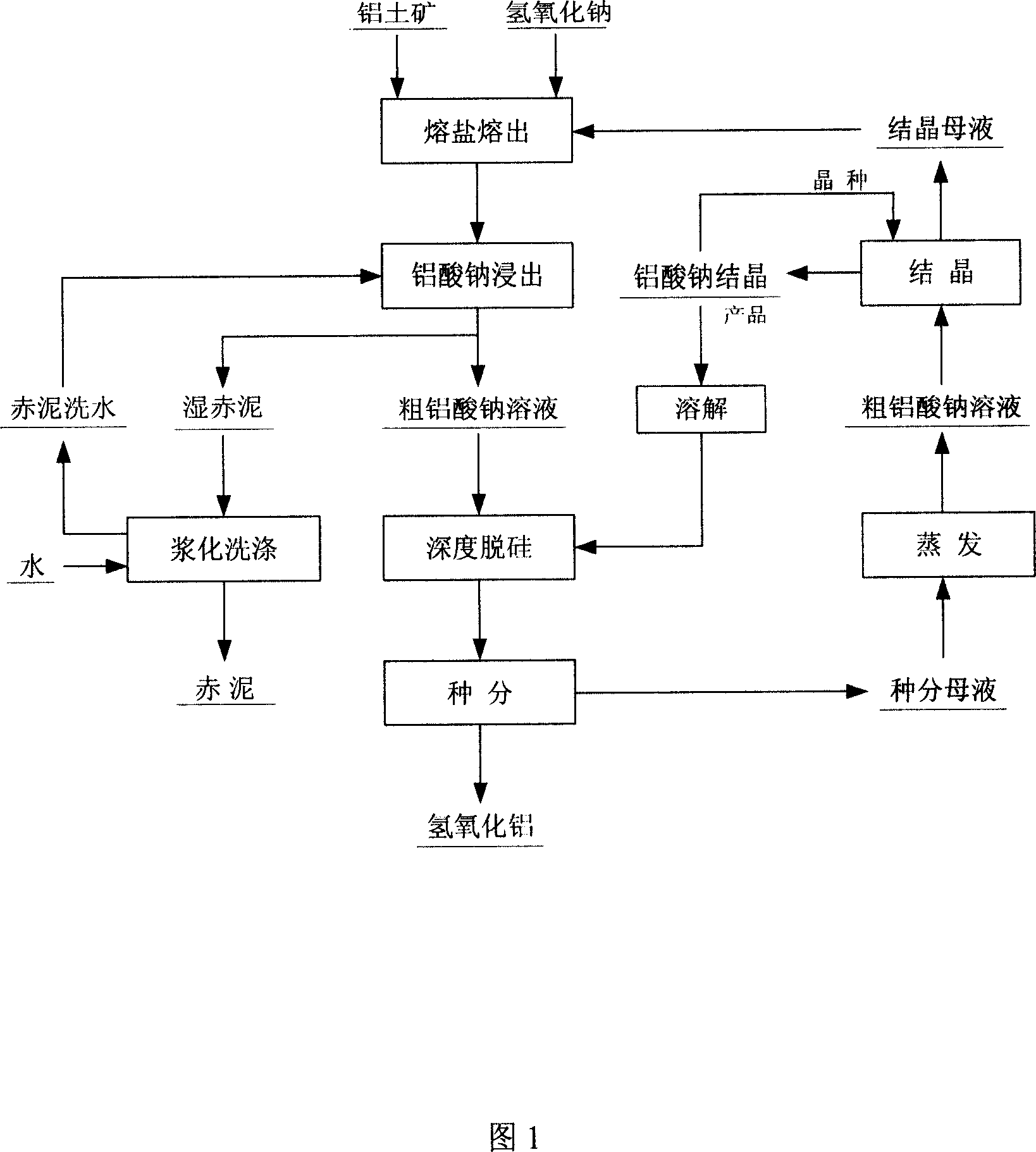Technique for processing bauxite to produce hydroted alumina with sodium hydroxide molten salt growth method
A technology of sodium hydroxide and aluminum hydroxide, which is applied in the preparation of alkali metal aluminate/alumina/aluminum hydroxide, etc., can solve the problems of difficult liquid-solid separation, complicated process, high reaction temperature, etc., and achieve easy follow-up operation, The effect of good product quality and simple process
- Summary
- Abstract
- Description
- Claims
- Application Information
AI Technical Summary
Problems solved by technology
Method used
Image
Examples
Embodiment 1
[0036]In the alkali-resistant reactor, 40g of 40wt% sodium hydroxide aqueous solution (prepared by adding water to 16 grams of analytically pure sodium hydroxide) and 20g of Guizhou bauxite ground to 100 mesh (the alumina content in the bauxite is 66.8%) Stir and mix evenly (the molar ratio of sodium oxide and aluminum oxide in the mixture is 1.5:1), heat the mixed solution to 350°C in the reaction kettle, and react at this temperature for 1h to make the aluminum oxide and hydroxide in the bauxite The sodium is fully reacted to obtain the dissolved clinker containing sodium aluminate. Cool down the eluted clinker containing sodium aluminate to about 100°C, add hot water at 90°C so that the concentration of sodium oxide in the sodium aluminate solution after leaching is 120g / L, after leaching for 30min, iron, titanium and most of the silicon The impurities remain in the solid phase to form red mud, and after the red mud is removed by filtration, a clarified sodium aluminate sol...
Embodiment 2
[0041] In a nickel stirred tank, 70ml of the sodium aluminate crystallization mother liquor (the concentration of the crystallization mother liquor is sodium oxide 578.6g / L, alumina 24.1g / L) and 50g of Guizhou bauxite are ground to 100 mesh (the content of alumina in the bauxite is is 66.8%), stirred and mixed evenly (the molar ratio of sodium oxide and aluminum oxide in the mixture is 2.0:1), the mixed solution is heated to 320°C in the reaction kettle, and reacts at this temperature for 2h to make the bauxite Alumina and sodium hydroxide are fully reacted to obtain leached clinker containing sodium aluminate. Cool down the eluted clinker containing sodium aluminate to about 100°C, add hot water at 80°C so that the concentration of sodium oxide in the sodium aluminate solution after leaching is 120g / L, after leaching for 30min, iron, titanium and most of the silicon Impurities remain in the solid phase to form red mud, and after removing the red mud by filtration, a clarified...
Embodiment 3
[0046] In the alkali-resistant reactor, 122g of 30wt% sodium hydroxide aqueous solution (prepared by adding water to 36.5 grams of analytically pure sodium hydroxide) and 50 g of Guizhou bauxite ground to 100 meshes (the alumina content in the bauxite is 66.8%) Stir and mix evenly (the molar ratio of sodium oxide and aluminum oxide in the mixture is 1.4:1). Heat the mixed solution to 600°C in the reaction kettle, and react at this temperature for 5 minutes to fully react the alumina and sodium hydroxide in the bauxite to obtain the leached clinker containing sodium aluminate. Cool down the eluted clinker containing sodium aluminate to about 100°C, add hot water at 95°C so that the concentration of sodium oxide in the sodium aluminate solution after leaching is 150g / L, after leaching for 30 minutes, iron, titanium and most of the silicon The impurities remain in the solid phase to form red mud, and after removing the red mud by filtration, a clarified sodium aluminate solution ...
PUM
 Login to View More
Login to View More Abstract
Description
Claims
Application Information
 Login to View More
Login to View More - R&D
- Intellectual Property
- Life Sciences
- Materials
- Tech Scout
- Unparalleled Data Quality
- Higher Quality Content
- 60% Fewer Hallucinations
Browse by: Latest US Patents, China's latest patents, Technical Efficacy Thesaurus, Application Domain, Technology Topic, Popular Technical Reports.
© 2025 PatSnap. All rights reserved.Legal|Privacy policy|Modern Slavery Act Transparency Statement|Sitemap|About US| Contact US: help@patsnap.com

